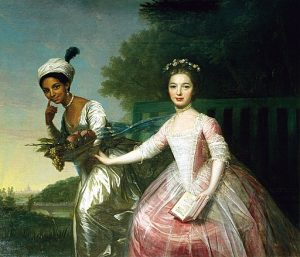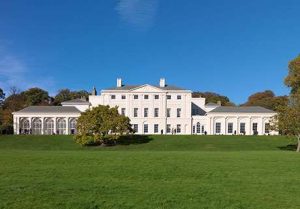Call for Participation HECAA@30: Roundtable Examining Intersectionality in Domestic Spaces

David Martin, Portrait of Dido Elizabeth Belle Lindsay and Lady Elizabeth Murray, c. 1778. © By kind permission of the Earl of Mansfield, Scone Palace, Perth, Scotland
Today’s post was written by Karen Lipsedge and Victoria Barnett-Woods about their panel for the upcoming HECAA@30 conference. In this post, they explore the multiple meanings inherent in the “Domestic Space” described in the title of their panel. Please find information below about how to submit a proposal to participate in their session.–ANR
The inspiration for our panel, “‘What’s Race Got to do with it?’: Interrogating the Norms of Domestic Space, Race, and Gender” at this year’s HECAA (Historians of Eighteenth-Century Art and Architecture), arose from a realization that as practitioners and academics we tend to normalize whiteness, both from the perspective of production as well as consumption. We tend not to consider who are the hidden voices integral to the architectural buildings that we visit and research and the objects, textual and non, with which we interact and furnish our own homes. Our roundtable panel at HECCA@30–held in Boston, October 12-14, 2023–seeks to take a step back and provide a space for us to ‘turn the glass inwards’ (to paraphrase Swift) and to reflect on our own practices as historians, as curators, as cultural and literary scholars.
In this panel, we’ll be considering a wide range of topics, from the influence that architectural design can have power dynamics of race and gender, to how art shapes our understanding of eighteenth-century values systems. David Martin’s portrait of Dido Elizabeth Belle Lindsay and her cousin Lady Elizabeth Murray, for example, reminds us that a core approach to the roundtable panel is intersectional in nature. As Jane Card highlights in her critical analysis of this double portrait, it both underscores and “challenges conventions from painting ‘exotic’ people” in the eighteenth century.
Dido was a dual-heritage woman, who was brought up by her great uncle Lord Mansfield at Kenwood House, London, along with her white cousin, Elizabeth. What has garnered most attention from academics about the work (Sutherland, 2021; Jeffries, 2014; Minney, 2005, for example) is the fact that the double portrait was, as Card wrote, “painted at a time when Britain participated in the transatlantic slave trade. This context is key as it raises questions about whether the portrait is as much about societal attitudes at the time as about the ‘circumstances of one girl’”. It is also a portrait that allows us as modern viewers to reflect upon our understanding of the eighteenth-century world. Viewing the portrait today permits us to reflect and reassess its meanings and import based on our mores and values, but potentially at the risk of eliding how this portrait may have been seen in the past.
The portrait of Dido and her cousin Elizabeth has a complicated history, though not nearly as complicated as the lives of the women who sat for it. Scholars know that the portrait was completed during Dido’s stay at Kenwood house, a majestic neoclassical villa redesigned for the 1st Earl of Mansfield, her great uncle. He was the most powerful judicial official in Great Britain, and the grandeur of Kenwood House serves as a testimony to that power. When looking closely at the portrait, Dido’s own expensive silk gown and pearl necklace reflect the aristocratic upbringing that she may have had while living with her great-uncle. The portrait was moved from Kenwood House to its current resting home in Scone Palace, Scotland, the generational home of the Earl of Mansfield. Her double portrait with her cousin hangs next to that of her father, Rear Admiral John Lindsay, his portrait only recently rediscovered. The Scone Palace discussion of the portraits implies a “family reunion.” But one does wonder, with Dido Belle’s comparative isolation in Kenwood House and her father consistently at sea, how much the father and daughter knew one another.
Indeed, additional questions emerge when considering the placement of the portrait in either Kenwood House or Scone palace. Such as, to what extent does this double portrait provide us with additional, accurate information about Kenwood House? Or how does architectural and landscape design, and domestic material culture either reflect or repress the daily lived experience of Belle Dido and Elizabeth Murray? We know that all these questions have been raised in recent attempts to uncover Dido Belle’s story; to ‘fill in the gaps’, as it were, where previously there were silences. Many of the answers to these questions can only be revealed from a thorough examination of the double portrait through the prism of an intersectional lens. But what we do with those ‘gaps’ is equally important to consider. Is it our role, in other words, to ‘fill in the gaps’ or is it to lean into them and to let the silences that arise ‘speak’?
As organizers of this roundtable, we are aware that we cannot ask the question, ‘What’s Race Got to do with it?’ by focusing on racial and ethnic identity alone. Categories of racial difference are simply a participant in the larger network of conversations surrounding the home, who resides in it and where, and the objects used to furnish it. Moreover, we firmly believe that it is our responsibility as scholars to think more comprehensively, and in nuanced, diverse, and potentially, challenging ways, about the home, gender and racial identity, and our role as practitioners, academics, and scholars in dismantling our colonial, Euro-centric approaches. We hope that in asking ‘What’s Race Got to Do With it?’ our roundtable panel will offer the opportunity to begin this work, together and with courage. We look forward to seeing you there!
If you would like to continue these conversations before or after the conference, please email Karen Lipsedge ([email protected]) and Victoria Barnett-Woods ([email protected])
